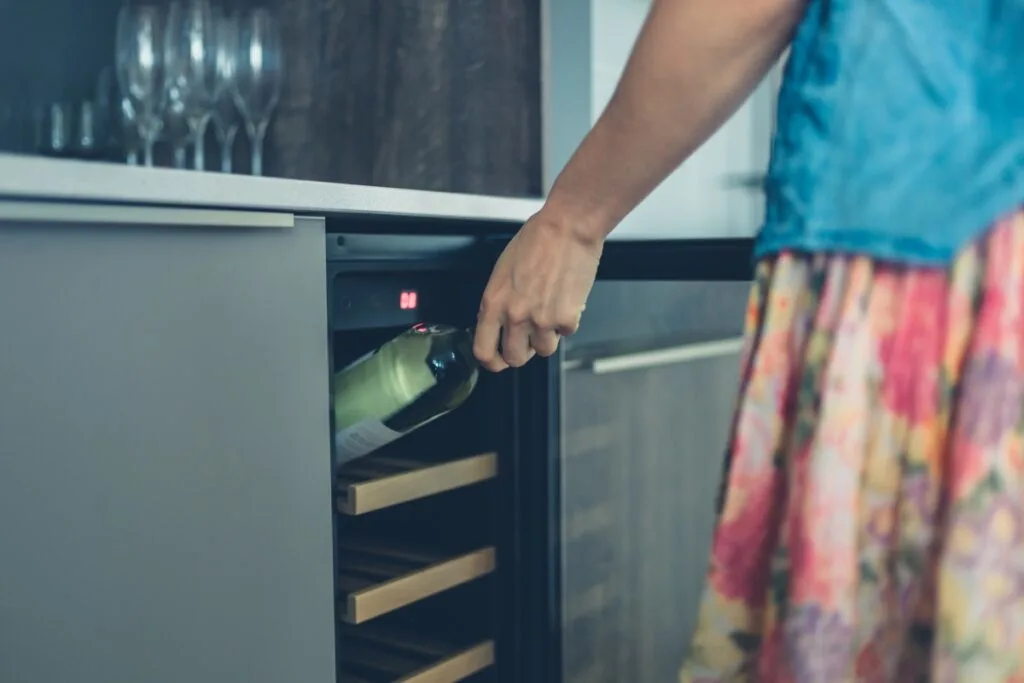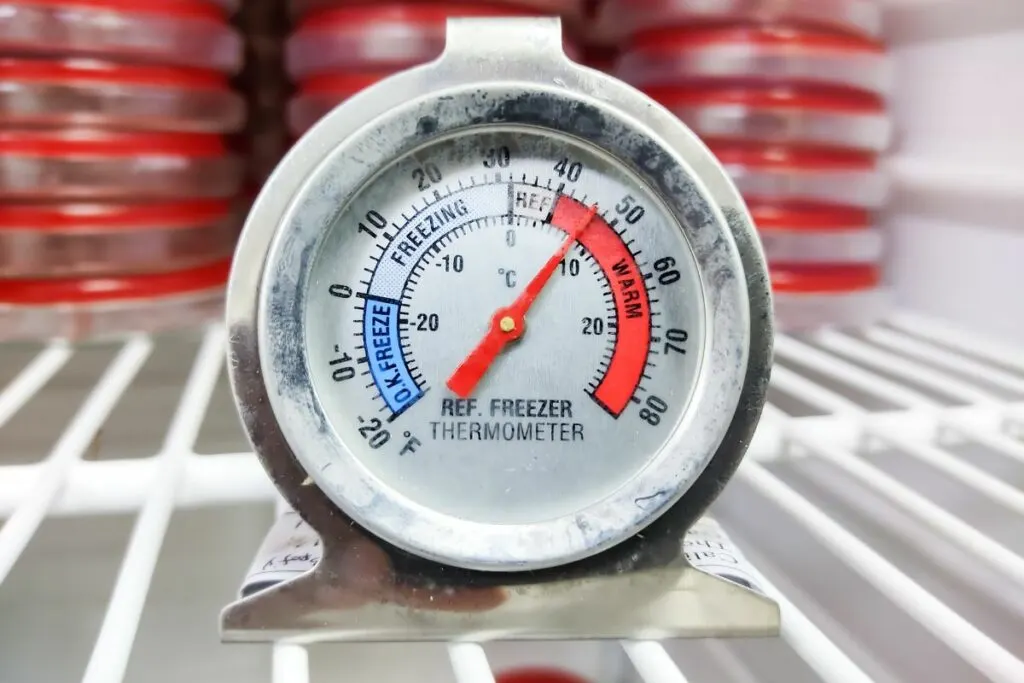As an Amazon Associate, I earn from qualifying purchases with no additional costs for you.
Are you a wine lover? Well, keeping an open bottle of wine for a long time can be challenging if you don’t have a wine fridge. A wine cooler can improve the lifespan of an open wine bottle.
A wine fridge is not just for wine lovers, though. They have many other benefits that you might not have guessed. A wine cooler is a great investment for both wine lovers and those who want to store other beverages.
So, if you’re wondering whether it’s worth investing in one, read this article to see reasons why your wine fridge might ice up, so you can decide if it will be the right purchase for you. Also, keep reading to see if you are able to fix a wine fridge that does ice up – including tips and tricks on fixing a wine fridge that has gotten too cold!

TIP: If you want to check out the best refrigerator for wine storage, I recommend trying out the Avation (18 bottles) compressor refrigerator with Wi-fi smart app control cooling system. You can find this refrigerator by clicking here (Amazon link).
Why is Ice Forming in My Wine Fridge
Ultimately, ice build-up occurs due to the presence of humid air. If there was no moisture content in the cooler, there would be no water vapor that could condense and freeze into ice. As mentioned above, the main culprit of ice forming in your wine fridge is warm, humid air.
Recommendation box: Everything you need to enjoy your wine as much as possible. All recommended products are personally tested and regularly used by experts from this website (Amazon links):
> Ivation Wine Cooler – Energy-efficient wine cooler for 18 bottles with Wi-fi smart app control cooling system.
> Wine Rack – Beautiful, elegant wood rack for up to 7 bottles and the choice of vertical or horizontal storage.
> Durand Wine Opener – Classic vintage wine opener (we like all these classic staff).
> YouYah Iceberg Wine Decanter – The most beautiful and handy wine decanter we personally use.
> Bormioli Rocco Wine Glasses – A set of eight elegant and traditional wine glasses made in Italy.
> Vintorio Wine Aerator – Simple but really useful wine aerator for a reasonable price.
> The Original Vacu Vin Wine Saver – The best wine saver on the market in a package with two vacuum stoppers and two wine servers.
And if you want to become a true connoisseur of wine, we recommend reading the book Wine Folly: The Essential Guide to Wine (Amazon link), where you will find all the information you need about winemaking, wine varieties, flavors, and much more.
Why does a wine fridge occasionally “freeze up”? Depending on the severity of your problem, this can take many forms.
On the less problematic end, you may notice frost buildup on the door and on the actual bottle of wine. On the more problematic end, you may see large ice crystals, warming temperatures, and damaged wine.
TIP: If your favorite bottle of wine has frozen, can you safely unfreeze it? Our 2 proven tips show you how! Which wines should be served at room temperature? Read this guide to find out.
Regardless of the intensity, no level of freezing up is desirable. Let’s try to better understand why your wine fridge may be freezing up.
- Damaged seals.
Regardless of the type of wine fridge that you have, it most certainly has a door that seals with rubber gaskets. Over time, the rubber material can start to degrade and lose some of its elasticity.
When this occurs, the seal between the door and the door frame starts to lose some of its integrity. As a result, warm air will start to leak into the wine fridge.
In some locations, such as desert climates, this effect may not cause a freeze-up due to the low ambient humidity. In other locations, such as the American Midwest or South, mild freeze-up can occur in just a few short hours.
- Faulty door mechanism.
It is also possible that the actual door mechanism itself is to blame for any leakage of warm air. Often, hinges are to blame. Over time, as hinges grow older and become more weighted, they can become misaligned with the door and frame.
This leads to gaps, often near the top or bottom of the door. Alternatively, the door closer can be faulty, not shutting the door completely. It may need to be adjusted or replaced.
TIP: If you want to learn how cold a wine refrigerator can get and why it is important for wine storage, check out this article. To learn my proven 8 steps for long-term wine storage, you must read this article.
Why Does My Wine Fridge Ice Up

A wine fridge will maintain the internal humidity between 50 and 80% and has sensors to ensure excessive levels aren’t reached. If moist air enters the wine cooler during the cooling period, the water molecules will condense and potentially freeze on the back wall of the wine fridge.
If you try to store your wine in a refrigerator, it will likely become too cold, and the wine will lose its flavor and aroma.
TIP: Most wines go bad once you pop the cork within a day or so. But a Coravin Wine Preservation system (available for a great price on Amazon) can extend the life of your opened wine for weeks or even months. It is awesome. You should check it out to see if it fits your lifestyle.
A wine fridge, on the other hand, is designed to maintain a temperature range of 50 degrees F to 80 degrees F, which is the perfect temperature for storing wine. That is unless your wine fridge ices up. Why does this happen? To put it simply, the answer is warm, humid air.
Many believe the benefits outweigh the downside of owning a wine fridge, one of those negatives being the problem of your wine fridge icing up. A big benefit of using a wine fridge is that it keeps your wine fresh for longer.
Wine is a delicate beverage, and it can start to spoil if it’s not stored properly. When wine is exposed to oxygen, it will oxidize, and the flavor will begin to change. A wine fridge prevents this by keeping your wine sealed off from the air, which means it will stay fresher for longer.
Let’s explore some other reasons why your wine fridge may be icing up. Keep reading!
TIP: A critical aspect of keeping wine for long periods is the correct temperature and humidity. Read this complete guide on how to control humidity in the wine fridge. Discover the most common reason why your wine cooler is not cooling in this article.
Why Does My Wine Fridge Keep Icing Up
A wine fridge is a refrigerator that is designed for the specific purpose of cooling and storing wine. While you could use a regular kitchen refrigerator to store your wine, it’s not ideal because refrigerators are built to maintain a temperature range of 40 degrees F to 45 degrees F, which is too cold for wine. However, regular refrigerators don’t have the hassle of icing up that some wine refrigerators do.
TIP: Are you interested in buying a wine stopper? We’ve personally tried and recommend buying one of these wine stoppers (Amazon links):
- The Original Vacu Vin Wine Saver: Our top choice. Very easy-to-use wine stopper/saver. You can enjoy a glass of fresh wine whenever you want without worrying about wasting any.
- EZBASICS Wine Saver: Great alternative to Original Vacu Vin Saver. This wine stopper keeps the flavor of wine for up to one week.
- Champagne Stopper by MiTBA: Wine stoppers for sparkling wines are different. This wine stopper seals your bottle and increases the pressure so your beverage’s bubbles won’t go to waste.
Some reasons your wine fridge might keep icing up are listed below.
Defrost timer. A defrost timer shuts off the refrigerator compressor at pre-scheduled intervals in order to allow your unit to defrost. Should your defrost timer be faulty, you could see significant ice build-up in your wine fridge.
Clogged drain line. The drain line of the evaporator coil can get clogged, and water vapor will back up, causing icing issues around the drain or on the coil itself. This is usually easy to spot and should be fixed right away.
TIP: The estimated cost to repair a wine fridge can range between $50 and $500, excluding the shipping costs for online purchased parts. The list of costs for all wine cooler parts is in the table below:
| Wine Cooler Part | Costs | Products on Amazon |
|---|---|---|
| Compressor | $100 – $600 | Best Compressors |
| Thermostat | $5 – $30 | Best Thermostats |
| Start relay | $7 – $16 | Best Start Relays |
| Condensor motor | $30 – $250 | Best Condensor Motors |
| Overload protector | $5 – $10 | Best Overload Protectors |
| Cooling fan unit | $10 – $25 | Best Cooling Fan Units |
| Control board | $60 – $250 | Best Control Boards |
| Temperature switching PCB | $30 – $50 | Best PCBs |
| Thermal plate | $30 – $50 | Best Thermal Plates |
How Do You Get Ice Out of a Wine Cooler
The best way to get ice out of a wine cooler is to defrost it without the risk of damaging the cooling lines. The way to do this is to empty it, unplug it, and wipe out the frost and water with a towel. If it is frosting over a lot, try reducing the temperature and get a thermometer for the inside so it doesn’t ruin your wine.
TIP: Many people worry if wine refrigerators are noisy and thus more appropriate for a garage. In this article, you’ll see that these concerns are mostly unfounded. This is a great article I wrote that will put your mind at ease.
Conclusion
Wine refrigerators are less expensive than building a wine cellar in your home. You’ll still be able to maintain the perfect temperature and humidity for your wines, but you won’t have to worry about the high costs associated with building a wine cellar.
In addition, to get the ideal storage conditions that you can quickly achieve with a wine refrigerator, you’ll need a cooling system that is constantly running and a humidifier to maintain proper humidity. This will be quite expensive, racking up your electricity bill.
On the other hand, a wine fridge provides a controlled environment that preserves your wine with the benefit of fitting your home, energy efficiency, and low maintenance costs.
With advanced features like dual-zone temperature, wine fridges have the ability to have independent temperature ranges to properly store both red and white wines within a limited space.
And as long as you know how to be proactive in keeping your wine fridge from icing up as well as using the tips and tricks we have learned here, you’ll be ready to own and manage that wine fridge like a pro!
TIP: Check out this page for a complete list of wine products and accessories I love. You’ll find my recommendations for wine refrigerators, decanters, and aerators and the best place to buy wine online. Click here to see the complete listing.
